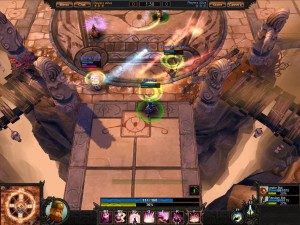If I said, ‘Let’s go play this sweet new MOBA1‘, would you know what I meant? What about if I said ASG2 instead of MOBA? Still nothing? Well how about DotA-clone3?
You see, game genres are a confusing mess at times. The list is littered with acronyms and abbreviations. Publishers don’t know whether to sell the gameplay, the aesthetic, or the purpose. And when a new genre comes along, it takes time for a name to stick. So if the ‘genrefication’ of games is such a minefield of labels and expectations, why bother having them at all?
Genre is defined as, “A class or category of artistic endeavour having a particular form, context or technique.” Movies genres, for example, are based on what happens, and are quite simple to comprehend. Walk into any video store and you will be met by shelves titled ‘Western’, ‘Action’ and ‘Horror’. Music is also readily distinguishable, though there are a lot of crossovers and mutations. Modern Jazz, Dubstep and Alternative are only some of the evolutions of Blues and Rock. Games, on the other hand, are subject to a collapse of form and context. Some genres, like FPS, are instantly recognisable. But what do you categorise Minecraft as? It’s viewed in first-person, but there’s very little shooting involved. In fact games carry definitions based on three different perspectives: the action involved (e.g. Real-Time Strategy), the aesthetic (e.g. Horror games), and the purpose (e.g. Serious games, Educational games). When developers mix these up, the volatile nature of consumer expectations means a misnomer can have disastrous effects.
Assigning a genre often means assigning a marketing strategy. Consumers know certain types of games, making it easy to slap on an acronym and add a gimmick like “RPG elements”. This melding of genres makes it difficult to accurately describe a game, but the marketing team still try. Players want to know how a game plays first and foremost, so mainstream genres focus on exactly what the player will be doing. However, were customers to expect a game with stealth mechanics, and then find it to have very little emphasis on this element, they would naturally be a little bitter (I’m looking at you, Splinter Cell Conviction). Getting the description wrong could have disastrous effects on sales. Initial buyers will soon spread the word that a game doesn’t meet certain ‘requirements’, and this will stifle sales significantly. Genres can also confine the creativity in a game.
Categorising a game can give a general overview for the buyer, but for the artist or designer it could box them into making Another Generic World War FPS (with RPG elements, of course). If we go back to my opening example, why do we need genres when it’s easier to say DotA-clone? Everyone will know what you mean, and there’s no need for silly abbreviations. This recognises the first game in a genre, and given that it would be widely known the descriptor works. That’s fine to a degree—I guess you should just go back to playing your Wolfenstein-clone.
Oh, wait. You see, genre definition becomes very important the longer a certain type of game is around for. If every shooter were a Wolfenstein-clone, there would be no innovation, nor experimentation. In order to progress the medium of games (and certainly in terms of progressing them as art) we need a taxonomy for it. There are roots for everything. Humans and apes share the same class known as primates. We are similar, but different. Music is the most obvious medium to share a similar ‘evolution’, but games have the potential to become even more diverse. I said that creativity can be restricted by genres and labels, but at the same time without them we will never know how to make something different. In time, DotA-clone as a title will die out, and some form of abbreviation will come out of the primordial goop that is the growing industry. Within the MOBA genre already Bloodline Champions shows how fresh ideas can shift the boundaries, while still retaining recognisable mechanics.
In order to study a medium, it helps to have labels. Literary studies involve such movements as Romanticism, Structuralism and Post-modernism, all of which naturally occurred because writers wanted to do something different. At the time they did not see themselves as a’ Modernist’–these titles came later so that the collective body of similar works could be studied. Now, I would never dream of doing a Structural reading of a game like Braid (though it is tempting), but in time games will form their own periods. The Atari era; FPSism; The Dark Age of RPG Elements. Will these be based on gameplay trends, or more on the console generations, given that games are so based in technology? The PC is where the majority of leaps will take place (and indeed have taken place). Revolutionaries like id Software will be examined and discussed, held with reverence for their mark on the FPS genre. Indie developers thrive on the PC, but also require constant innovation. For example, after the almost perfect Defense Grid, where was the Tower Defense genre to go? Well, ask yourself what’s more imaginative: the hybrid of Tower-D and FPS that is Sanctum, or the reverse Tower-D that is Anomaly: Warzone Earth. Both games take the genre to fascinating new places. It may seem silly now, but given time the validity of digital games will change dramatically as we build a taxonomy and language.
Everything needs a name. It helps us as humans to differentiate, to discern and to comprehend the objects and patterns around us. Games are no different. It may be easier to say DotA-clone, but what happens when that genre diverges? Often a label is a marketing tool, but with games this can be treacherous territory. We need to define and streamline game genres, not only for the benefit of the consumer, but more for the benefit of the medium. It’s the first step to bigger ideals. Innovation doesn’t just strike; it seeps out of structure.
1 MOBA is an acronym for Multiplayer Online Battle Arena
2 ASG is a different acronym for the MOBA genre, and stands for Action Strategy Game
3 DotA is the original game from this genre, and stands for Defence of the Ancients


should’ve been the ‘dark ages of the j-rpg’, maybe even the decline or death thereof.
This certainly hasn’t happened to Rogue and its namesakes, the Roguelikes.
That is a very good point. Perhaps DotAclone will remain the category, though I really hope not.
I really feel dumber after reading this, and to read the whole thing did take considerable effort. It seems like you wrote the 1st half of the article, came back a month later and forgot what your initially wrote and then slammed your own initial argument. I’m confused, but games, like everything else in life needs words and a classification to help us lowly humans know WTF ppl are talking about without going into too much detail…Brain hurts.
While I do see some of your points (your post is a little haphazard) I believe the transition is pretty clear. I presented two sides of the issue in order to more strongly enforce the latter one. I believe in the use of genres but some don’t see them as particularly important, which was shown in the first part of the piece.